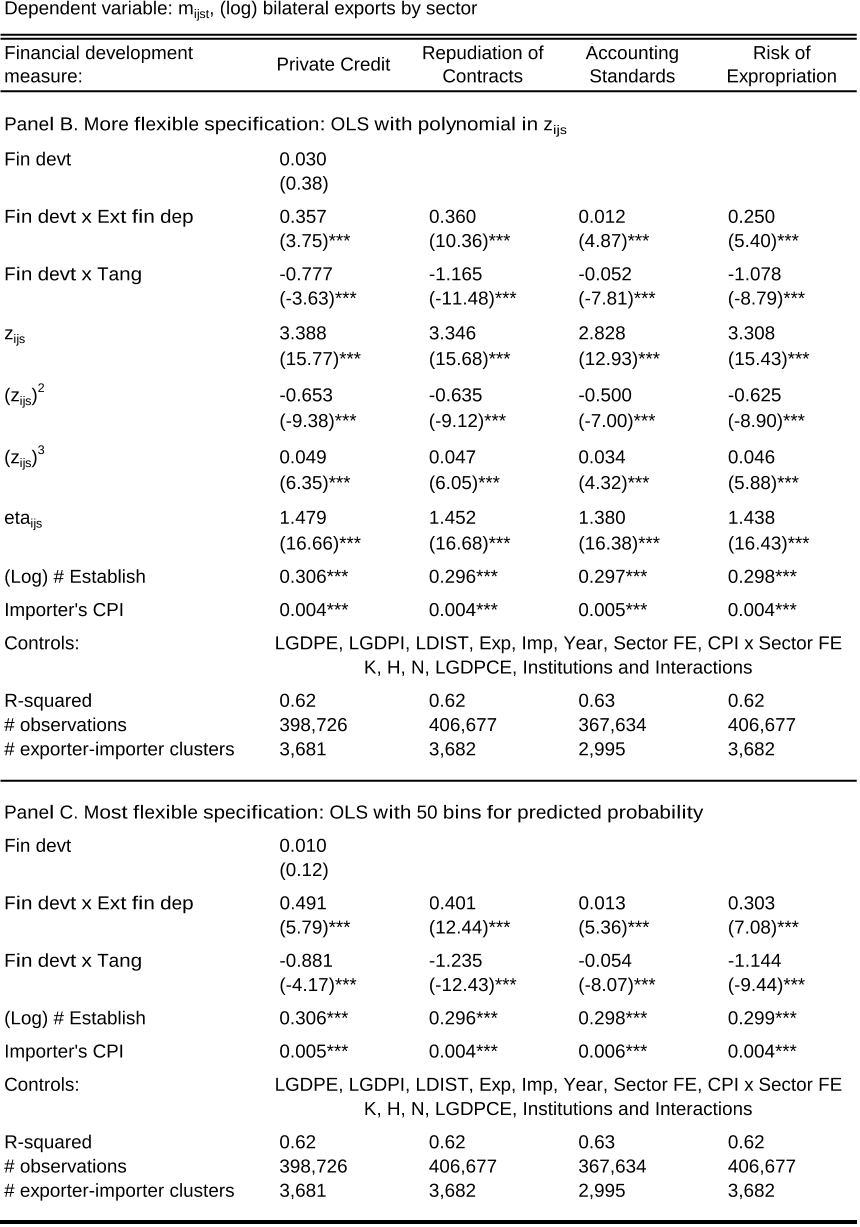Credit Constraints, Heterogeneous Firms and International Trade
Reads0
Chats0
TLDR
This article examined the detrimental consequences of financial market imperfections for international trade and developed a heterogeneous-firm model with countries at different levels of financial development and sectors of varying financial vulnerability.Abstract:
This paper examines the detrimental consequences of financial market imperfections for international trade. I develop a heterogeneous-firm model with countries at different levels of financial development and sectors of varying financial vulnerability. Applying this model to aggregate trade data, I study the mechanisms through which credit constraints operate. First, financial development increases countries' exports above and beyond its impact on overall production. Firm selection into exporting accounts for a third of the trade-specific effect, while two thirds are due to reductions in firm-level exports. Second, financially advanced economies export a wider range of products and their exports experience less product turnover. Finally, while all countries service large destinations, exporters with superior financial institutions have more trading partners and also enter smaller markets. All of these effects are magnified in financially vulnerable sectors. These results have important policy implications for less developed economies that rely on exports for economic growth but suffer from poor financial contractibility.read more
Figures

Table 10. Economic Significance: Predicted vs. Actual Trade Growth 
Table 9. Economic Significance: Comparative Statics 
Table 5. Financial Development and Firm-Level Exports 
Figure 3. The Productivity Cut-off for Exporting 
Table 5. Financial Development and Firm-Level Exports 
Table 1. Export Patterns in the Data
Citations
More filters
Journal ArticleDOI
Bank Internationalization and Firm Exports: Evidence from Matched Firm–Bank Data
TL;DR: In this paper, the authors investigate whether new exporter firms have a higher probability of starting to export to the countries where their financing banks have already established their branches, and they find a significant positive relationship between a firm's probability of beginning to export in one market and the presence in the same market of a branch of the firm's financing bank.
Journal ArticleDOI
Financial constraints and R&D and exporting strategies for Spanish manufacturing firms
TL;DR: In this paper, the authors investigate the role of internal and external financial constraints in the firms' joint decision to export and invest in R&D. They use objective measures at the firm level such as cash flow and financial costs, and analyze both if firms' size and the onset of the current economic crisis have had an impact.
Journal ArticleDOI
Banking competition and firm-level financial constraints in Latin America
TL;DR: In this paper, the authors analyzed the relation between banking competition and financial constraints and found that the negative impact of competition is higher for small quoted firms and for low-assets tangibility industries.
Journal ArticleDOI
Scarring recessions and credit constraints : evidence from Colombian firm dynamics
TL;DR: In this article, the authors show that financially constrained businesses may be forced to exit the market during recessions even if they are more productive than surviving unconstrained counterparts, and they illustrate scarring effects of recessions operating through inefficient exit induced by heterogeneous credit constraints.
ReportDOI
Labor Market Frictions as a Source of Comparative Advantage, with Implications for Unemployment and Inequality
TL;DR: This article explored the dynamics of the division of labour from technological, capital, and political perspectives, including gender, the firm, countries economic specializations, ICTs, foreign direct investment and agriculture.
References
More filters
Posted Content
Law and Finance
Rafael La Porta,Rafael La Porta,Florencio Lopez de Silanes,Florencio Lopez de Silanes,Andrei Shleifer,Andrei Shleifer,Robert W. Vishny,Robert W. Vishny +7 more
TL;DR: This paper examined legal rules covering protection of corporate shareholders and creditors, the origin of these rules, and the quality of their enforcement in 49 countries and found that common law countries generally have the best, and French civil law countries the worst, legal protections of investors.
Journal ArticleDOI
Law and Finance
TL;DR: In this article, the authors examined legal rules covering protection of corporate shareholders and creditors, the origin of these rules, and the quality of their enforcement in 49 countries and found that common-law countries generally have the strongest, and French civil law countries the weakest, legal protections of investors, with German- and Scandinavian-civil law countries located in the middle.
Journal ArticleDOI
The Impact of Trade on Intra-Industry Reallocations and Aggregate Industry Productivity
TL;DR: This paper developed a dynamic industry model with heterogeneous firms to analyze the intra-industry effects of international trade and showed how the exposure to trade will induce only the more productive firms to enter the export market (while some less productive firms continue to produce only for the domestic market).
Journal ArticleDOI
Finance and Growth: Schumpeter Might Be Right
TL;DR: In this paper, the authors examined a cross-section of about 80 countries for the period 1960-89 and found that various measures of financial development are strongly associated with both current and later rates of economic growth.
ReportDOI
Financial Dependence and Growth
Raghuram G. Rajan,Raghuram G. Rajan,Raghuram G. Rajan,Luigi Zingales,Luigi Zingales,Luigi Zingales +5 more
TL;DR: This paper examined whether financial development facilitates economic growth by scrutinizing one rationale for such a relationship; that financial development reduces the costs of external finance to firms, and found that industrial sectors that are relatively more in need of foreign finance develop disproportionately faster in countries with more developed financial markets.